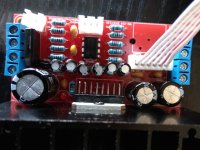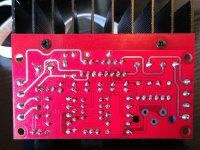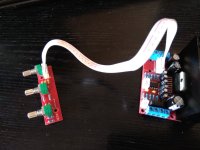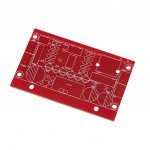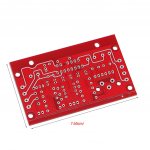Newbie first learning project here, a TDA7377 2.1 board kit:
12-18V DC TDA7377 Power Amplifier 2.1 DIY kit 3 Channel Sound Audio AMP Board 665980427782 | eBay
Everything soldered and assembled as carefully as possible. Connected a smartphone as source, a small subwoofer 8ohm 5.5", two small 4ohm loudspeakers and a 12V AC transformer for power. Audio signal gets amplified and coming through the speakers as expected.
The problem is a persisting humming noise around 50Hz only from the subwoofer channel. The stereo channels are dead clean. Swapped a loudspeaker to the subwoofer channel and the noise is still there. Also tried a few other transformers AC or DC (wall wart), connected an additional 3300uF smoothing capacitor, disconnected the input jack, checked thoroughly all soldering points for possible problems, cleaned carefully all remaining flux, but nothing changed.
Also, the kit has a separate volume control board. The noise is there whether it is connected or not to the main board. Volume and tone potentiometer do not have any effect on the noise. A third potentiometer controls the subwoofer volume and this makes the hum noise louder in the absolute lower and absolute higher position.
The hum went away only if a 36V meanwell switching power supply with XL4015 step down module a was used. Plain silence in all speakers (according to my ears, sorry no oscilloscope here yet). Maybe because a SMPS "vibes" above the audible spectrum?
For long hours I read resources around the net and while I try to troubleshoot the problem, I have gained some new knowledge about circuits, components, amplifiers and all this magic. In this board I see that the L/R channel inputs are connected directly to the TDA7377, but the subwoofer input is connected to a NE5532 op amp before it gets to the other two channels of the TDA7377 at pins 11,12 in stereo/bridge configuration. Hum noise gets louder if a finger touches the pins of the op amp.
Anyone having experience with this board or any hints regarding this kind of problem?
Thanks for reading!
12-18V DC TDA7377 Power Amplifier 2.1 DIY kit 3 Channel Sound Audio AMP Board 665980427782 | eBay
Everything soldered and assembled as carefully as possible. Connected a smartphone as source, a small subwoofer 8ohm 5.5", two small 4ohm loudspeakers and a 12V AC transformer for power. Audio signal gets amplified and coming through the speakers as expected.
The problem is a persisting humming noise around 50Hz only from the subwoofer channel. The stereo channels are dead clean. Swapped a loudspeaker to the subwoofer channel and the noise is still there. Also tried a few other transformers AC or DC (wall wart), connected an additional 3300uF smoothing capacitor, disconnected the input jack, checked thoroughly all soldering points for possible problems, cleaned carefully all remaining flux, but nothing changed.
Also, the kit has a separate volume control board. The noise is there whether it is connected or not to the main board. Volume and tone potentiometer do not have any effect on the noise. A third potentiometer controls the subwoofer volume and this makes the hum noise louder in the absolute lower and absolute higher position.
The hum went away only if a 36V meanwell switching power supply with XL4015 step down module a was used. Plain silence in all speakers (according to my ears, sorry no oscilloscope here yet). Maybe because a SMPS "vibes" above the audible spectrum?
For long hours I read resources around the net and while I try to troubleshoot the problem, I have gained some new knowledge about circuits, components, amplifiers and all this magic. In this board I see that the L/R channel inputs are connected directly to the TDA7377, but the subwoofer input is connected to a NE5532 op amp before it gets to the other two channels of the TDA7377 at pins 11,12 in stereo/bridge configuration. Hum noise gets louder if a finger touches the pins of the op amp.
Anyone having experience with this board or any hints regarding this kind of problem?
Thanks for reading!
Attachments
It seems you forgot to solder two points.  One is slightly off-center to the left on the second image, the other is on the left pin of the connector at the bottom. Furthermore, some other connections might need to be resoldered - they should like shiny and smooth and evenly cover the whole c. When soldering, pre-heat the point to be soldered with your soldering iron before adding solder, then add solder with a resin core, then give the solder some time to flow. Be careful with heat sensitive components, as heating them for more than a few seconds might cause damage.
One is slightly off-center to the left on the second image, the other is on the left pin of the connector at the bottom. Furthermore, some other connections might need to be resoldered - they should like shiny and smooth and evenly cover the whole c. When soldering, pre-heat the point to be soldered with your soldering iron before adding solder, then add solder with a resin core, then give the solder some time to flow. Be careful with heat sensitive components, as heating them for more than a few seconds might cause damage.
By the way, I see the tab of the TDA7377 is not flat, which could mean it is a counterfeit part.
By the way, I see the tab of the TDA7377 is not flat, which could mean it is a counterfeit part.
Last edited:
Thanks for the hint. I plan on doing optimizatios as soon as this kit works properly. But it buzzes even without the ribbon connected.I Would get rid of that ribbon and implement a shielded cable scheme instead.
Correction: ... evenly cover the whole copper pad on the circuit board that lies around the pin.they should like shiny and smooth and evenly cover the whole c.
It seems you forgot to solder two points.One is slightly off-center to the left on the second image, the other is on the left pin of the connector at the bottom. Furthermore, some other connections might need to be resoldered - they should like shiny and smooth and evenly cover the whole c. When soldering, pre-heat the point to be soldered with your soldering iron before adding solder, then add solder with a resin core, then give the solder some time to flow. Be careful with heat sensitive components, as heating them for more than a few seconds might cause damage.
By the way, I see the tab of the TDA7377 is not flat, which could mean it is a counterfeit part.
Thanks for the observation, and for the hints and tips. The photos were captured in the middle of redoing some suspicious joins and getting out some components for measuring. The humming noise is still there. But I have learned that this Chinese pcb don't like desoldering pumps
It is probably a fake TDA7377 considering the price of the kit. I'd expect a suboptimal performance from such part but not a functional problem as buzzing, at least according to the available reviews. But still, there are lots to learn.
- Status
- This old topic is closed. If you want to reopen this topic, contact a moderator using the "Report Post" button.
- Home
- Amplifiers
- Chip Amps
- TDA7377 2.1 subwoofer hum noise
